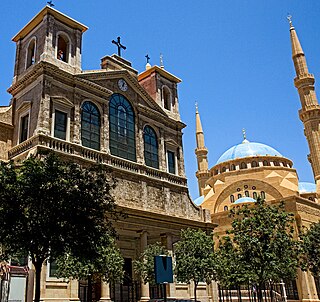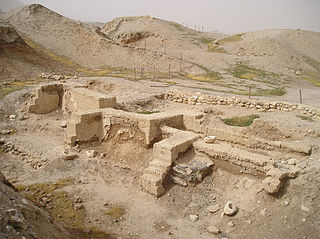Related Research Articles

Mount Carmel, also known in Arabic as Mount Mar Elias, is a coastal mountain range in northern Israel stretching from the Mediterranean Sea towards the southeast. The range is a UNESCO biosphere reserve. A number of towns are situated there, most notably Haifa, Israel's third largest city, located on the northern and western slopes.

Deir al-Balah or Deir al Balah is a Palestinian city in the central Gaza Strip and the administrative capital of the Deir el-Balah Governorate of the State of Palestine. It is located over 14 kilometers (8.7 mi) south of Gaza City. The city had a population of 75,132 in 2017. The city is known for its date palms, after which it is named.

Kadisha Valley, also romanized as the Qadisha Valley and also known as the Kadisha Gorge or Wadi Kadisha, is a gorge that lies within the Bsharri and Zgharta Districts of the North Governorate of Lebanon. The valley was carved by the Kadisha River, also known as the Nahr Abu Ali when it reaches Tripoli. Kadisha means "Holy" in Aramaic, and the valley is sometimes called the Holy Valley. It has sheltered Christian monastic communities for many centuries. The valley is located at the foot of Mount al-Makmal in northern Lebanon.

Umm ar-Rasas, ancient name: Kastron Mefa'a, is located 30 km southeast of Madaba in the Amman Governorate in central Jordan. It was once accessible by branches of the King's Highway, and is situated in the semi-arid steppe region of the Jordanian Desert. The site has been associated with the biblical settlement of Mephaat mentioned in the Book of Jeremiah. The Roman military utilized the site as a strategic garrison, but it was later converted and inhabited by Christian and Islamic communities. In 2004, the site was inscribed as a UNESCO World Heritage Site, and is valued by archaeologists for its extensive ruins dating to the Roman, Byzantine, and early Muslim periods. The Franciscan academic society in Jerusalem, Studium Biblicum Franciscanum (SBF), carried out excavations at the north end of the site in 1986, but much of the area remains buried under debris.

Old Cairo is a historic area in Cairo, Egypt, which includes the site of a Roman-era fortress, the Christian settlement of Coptic Cairo, and the Muslim-era settlements pre-dating the founding of Cairo proper in 969 AD. It is part of what is referred to as Historic Cairo, a UNESCO World Heritage Site.

The tourism industry in Lebanon has been important to the local economy historically and comprises a major source of revenue for the country.

Levantine archaeology is the archaeological study of the Levant. It is also known as Syro-Palestinian archaeology or Palestinian archaeology. Besides its importance to the discipline of Biblical archaeology, the Levant is highly important when forming an understanding of the history of the earliest peoples of the Stone Age.

Al-Maghtas, officially known as Baptism Site "Bethany Beyond the Jordan", is an archaeological World Heritage Site in Jordan, on the east bank of the Jordan River, reputed to be the original location of the Baptism of Jesus by John the Baptist and venerated as such since at least the Byzantine period. The place has also been referred to as Bethabara and historically Bethany.

Deliberate destruction and theft of cultural heritage have been conducted by the Islamic State (IS) since 2014 in Iraq, Syria, and to a lesser extent in Libya. The destruction targets various places of worship under IS control and ancient historical artifacts. In Iraq, between the fall of Mosul in June 2014 and February 2015, IS had plundered and destroyed at least 28 historical religious buildings. Valuable items from some buildings were looted in order to smuggle and sell them to foreigners to finance the running of the Islamic State.
Umm (أمّ) means mother in Arabic. It is a common Arabic feminine given name and generic prefix for Semitic place names. It may refer to:
Tell Umm el-'Amr, also known as Tell Umm Amer, is an archaeological site located in the Nuseirat refugee camp, Deir al-Balah Governorate, Gaza Strip, Palestine.
References
- ↑ "New archaeological discovery in St. Hilarion Monastery". Al-Monitor . 2021-04-13. Retrieved 2016-04-15.
- 1 2 3 Hirschfeld, Yizhar (2004). "The monasteries of Gaza: An archaeological review". In Brouria Bitton-Ashkelony; Aryeh Kofsky (eds.). Christian Gaza in Late Antiquity. Brill. pp. 67–69. ISBN 9789004138681 . Retrieved 12 November 2023.
- ↑ Centre, UNESCO World Heritage. "Tell Umm Amer". UNESCO World Heritage Centre. Retrieved 2022-10-22.
- ↑ "Tell Umm El-'Amr (Saint Hilarion Monastery) | World Monuments Fund". Wmf.org. Retrieved 2016-12-07.
- ↑ "Middle East Monitor – Latest news from the Middle East and North Africa". Middleeastmonitor.org.uk. 2016-12-02. Retrieved 2016-12-07.
- ↑ "GHN Sites". Archived from the original on 2014-07-14.
- ↑ "Gaza: UNESCO grants enhanced provisional protection to Saint Hilarion monastery". UNESCO. 2023-12-18. Retrieved 2024-03-31.